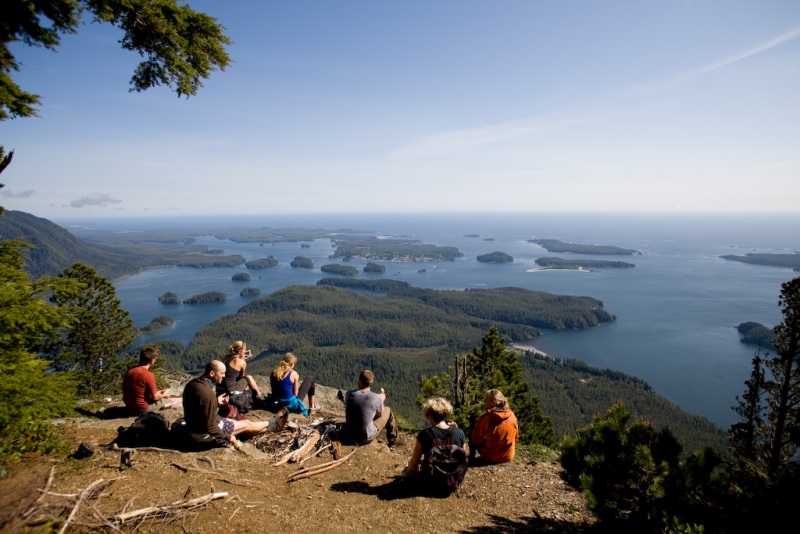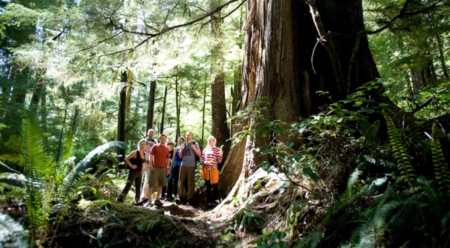Backyard Adventures: Surfing and Hiking Lone Cone in Tofino
A few weeks ago some of the folks from the California office cruised up to our part of the coast. Glen Morden, one of Patagonia’s product designers, is a transplanted Canadian, so he was piloting the minivan as they rolled across the Island and into town. They showed up on a typical Tofino day—thick cloud, sheets of rain and fun little wind-groomed waves at Cox Bay. Glen and I used to be cursed every time we surfed together, but after a few hours of waves on that first day it seemed that our luck had finally been lifted.
From then on, the rest of the week in Tofino turned out to be pretty grand. The sun came out, the weather warmed up and the Californians caught some lovely slabs of fish with the guys from Jay’s Clayoquot Ventures. There were a few swims in the clear water of the Sound, and we managed to work a trip up Lone Cone into the schedule—one of the two main peaks on Meares Island, it’s a great upward grind that leads through some of the lushest old growth on the coast. It’s a bit of a burn for the legs, but the view you get from the top is always worth the work.
We set off for Lone Cone on a weekday afternoon, piling into boats for the short ride over to the docks at Kakawis. Set into the forest at the foot of the mountain, Kakawis is the former site of the Christie Indian Residential School, one of the many institutions in Canada that separated First Nations children from their families in a century-long attempt to merge them into white culture. It was one of the last of the schools in Canada to close, and the site has now become the home of the Kakawis Family Development Centre, a holistic recovery and healing centre for Nuu-chah-nulth families. There’s some heavy energy in the area, but there’s a certain degree of strength in the fact that local cultures are surviving here and that the surrounding land is still relatively intact. Much of First Nations society was based on practical and spiritual connections to the land and its natural systems, and the future for everyone here is dependent on being able to effectively reconnect with the forest and the rivers and the sea. If the land stays alive, so too can the cultures of all of us who have made the coast our home.

John Rapp and black slug. Photo: Jeremy Koreski

Sneaking under an old windfall. Photo: Jeremy Koreski
As you leave Kakawis, the trail turns off a short gravel road and winds into the trees. The first section is thick and muddy bog land, but as the trail hits the mountain you start climbing into beautiful temperate rainforest—the understory of salal and fern, the many thousands of hemlocks, and the huge and twisted red cedars that have been growing here since long before any of the trading ships showed up. Clayoquot Sound has been a centre of resource controversy for decades, and Meares Island is one of the places here that have been tentatively preserved through a combination of civil disobedience and legal action. The island’s landscape is stunning, and it’s hard to imagine it being bulldozed and clearcut—much of the British Columbia coast has been devastated by unsustainable harvesting practices, and it’s easy to forget how hard people have had to fight to keep even the smallest sections intact. There are land use models that can certainly work, though, and as you climb higher on the mountain you pass a few stands of young cedars that have had their bark harvested for traditional use—mostly gathered by girls and women, cedar fibre was the nylon of the pre-colonial coast, used for everything from clothing to ropes and fish nets and food containers. The wood laid open by the triangular cuts is clear and bright, and it’s a living example of a sustainable way of living with the land—take only what you need, and leave the trees to thrive and grow.

Cedars that have been marked by bark harvesting. These are referred to as culturally modified trees or CMTs. Photo: Jeremy Koreski

Getting towards the top of Lone Cone. Photo: Jeremy Koreski
The trail to the top of Lone Cone is a sort of wilderness version of the Grouse Grind in Vancouver. It’s a narrow, switchbacking path with a gradient that never really gives you a rest. It’s steep enough that you can always see sky up ahead—you always think you’re almost there, though you’re usually not. It’s when your legs are really starting to feel it that the trail levels off and comes out onto the rock outcropping that looks back towards Tofino and out to sea. It’s one of the best views anywhere, and it gives you an entirely different perspective on the area: Tofino is tiny and folded into the trees, the surf beaches reach away to the south, and the ocean is huge and endless and blue as it stretches off to the curve of the Earth. We got our water bottles out and sat at the top for a good long while, admiring the view and snapping photos while a few boats left contrails on the water and scraps of cloud drifted by overhead. By that time, the talk had been turning to food and dinner, so we loaded up and headed back down, the next stops being the crab traps for the main and the Maquinna for a few bottles of decent wine.

Looking back towards Tofino. Photo: Jeremy Koreski
It’s a good life up here, and it was great fun that week to have some of our friends up from the south. It’s always good to see where you live through the eyes of others, and it’s always good to be reminded of what we have here. The real value of the Sound isn’t in its resources, but rather in what its human and natural communities can show us—the great simple lessons of an ecosystem living in balance with itself. Here’s to taking only what we need and leaving the rest to grow.
Many thanks to Jeremy Koreski and Sarah Davies-Long for the boat, the floathouse and the generous hospitality.

